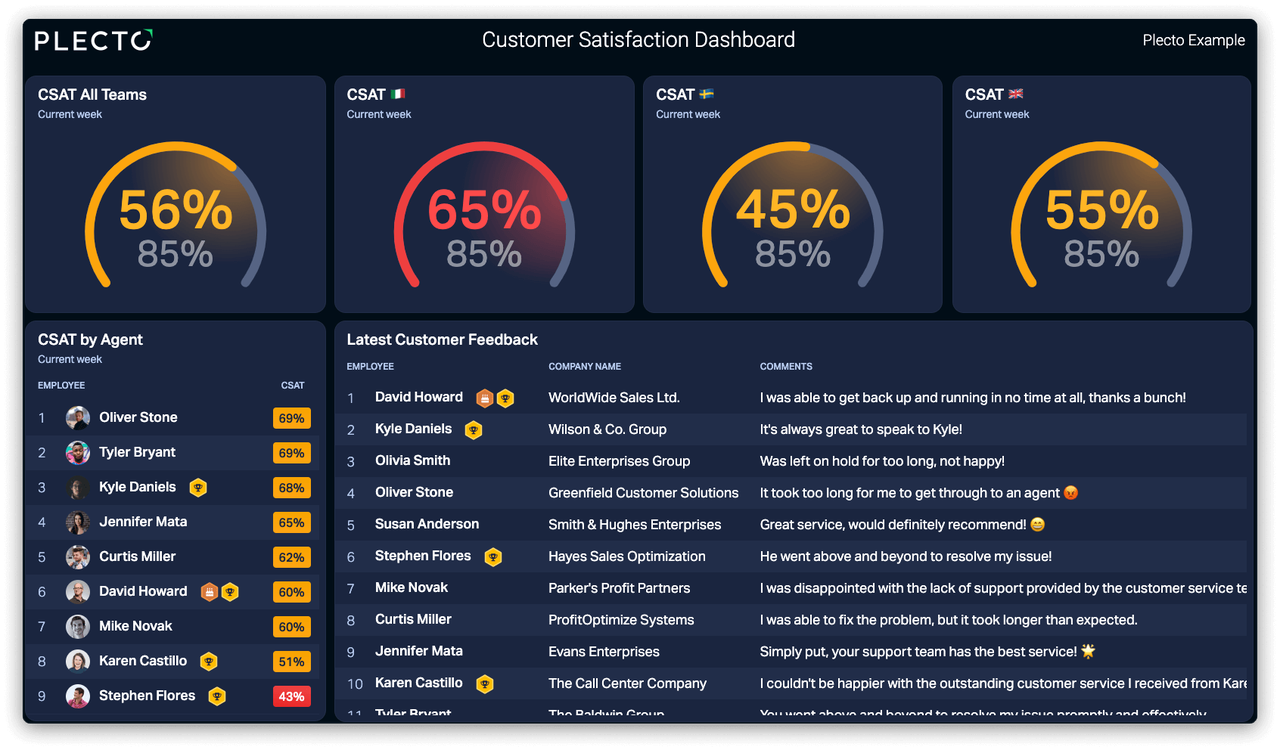An estimated 90% of Americans cite customer service as a deciding factor in whether or not to do business with a company. 50% say they’d take their business elsewhere after one bad customer service experience – that number increases to 80% after more than one bad experience. With these statistics, it’s clear that companies must provide stellar customer service if they want to succeed in the future.
Building customer rapport over the phone can effectively reduce churn rates and solidify customer loyalty. Conversely, failing to get it right can have disastrous long-term consequences. Read on to discover where most companies go wrong and learn ten of the best ways to build customer rapport and stay ahead of the competition.
Why is good customer service rapport important?
Delivering outstanding customer service is one of the easiest ways to retain customers, and it’s an important indirect revenue driver. By some estimates, increasing customer retention by as little as 5% can increase profits by 20%. But answering customer inquiries and resolving issues quickly is only part of providing great customer service.
Establishing good customer service rapport builds an emotional connection that makes customers feel comfortable and confident in the rep’s ability to help them. Customer service reps will attest that finding a good solution is much easier when they’re working with a customer who is receptive to what they have to say. This is why seasoned customer service reps try to build rapport from the second they answer a call. Once a rapport has been established, customers are more likely to open up and trust the rep to help them resolve any challenges incurred. As a result, they’re more likely to hang up with a positive experience that can lead to repeat business and word-of-mouth recommendations.
Find out how you can develop even better customer experiences by creating real-time customer experience dashboards, in this article, or learn about using SaaS customer journey maps.
Building Good Customer Service Rapport Can Be a Challenge
Building good customer service rapport requires the right combination of friendliness and professionalism. Customer service can seem like a thankless job. Some days, it feels like an endless stream of complaints and opposition. It’s enough to dampen even the most positive spirits. It’s easy for reps to get exasperated and try to mask their frustration by falling into comfortable rote conversations that seem cold and scripted – or overcompensating by being excessively apologetic, potentially thwarting any kind of esteem and good standing that had been developed.
4 Common Mistakes Customer Service Reps Make When Trying to Build Rapport
Customer service reps may be subconsciously sabotaging their efforts in the endeavor to build good customer service rapport. Finding the sweet spot of being polite, assertive, welcoming, professional, and authentic, is key to building positive customer rapport. Easier said than done. Here are 4 common mistakes customer service reps make in their efforts to build rapport with customers. Take note of whether you are guilty of falling into any of the following next time you are on the phone with a customer:
1 – Sounding insincere
While it’s important to give the impression that the rep is committed to finding a great solution, acting overly concerned is likely to have the opposite of its intended effect. Building rapport is based on honesty, so coming across as authentic is more effective than being fake and seeming a little too concerned.
Hearing “finding a solution for you is my number-one priority” is likely to get more eye-rolls than brownie points. Or maybe not, it depends on how you deliver what you’re saying. When customers sense overcompensating people-pleasing, or on the other hand, that they are speaking to a robot, they are less inclined to accept that you care about finding a positive outcome for them.
2 – Too much small talk
Time is money for both the company and the customer. Customer service reps should be friendly but keep small talk to a minimum. They’re there to solve problems, not be everyone’s new best friend. Too much, or bland filler small talk, can be offputting for a customer who just wants a solution to their challenge.
This can be particularly common in B2B customer service teams where a customer may have been on the phone or support chat several times prior to your call, working to resolve challenges their business is facing with other companies' products or services.
3 – Being too casual and familiar
While building rapport is important, this is still a business/customer relationship. Reps should be professional and respectful – and not overstep by being overly familiar or speaking too casually. A big mistake customer service reps often make is not ‘reading the room’. If the customer is not open to the kind of enthusiastic correspondence you are delivering, it’s time to tone it down.
There’s a difference between being lively and fanatical. If every bit of information a customer shares is met with “awesome” or “fantastic,” care should be taken that it’s not coming across as insincere or that they are being befriended – particularly when this is not the clear vibe and intention of the call.
4 – Sounding scripted
Templates can improve efficiency and are great for helping reps navigate resolutions to common inquiries, but customer interactions should never sound scripted. Think of scripts as a roadmap to resolving issues vs. something to be repeated verbatim. Reps should listen to what the customer is saying and then respond in their own words. Scripted responses can be interpreted as impersonal and apathetic.
Build your first dashboard.
Start your 14-day free trial today
10 Best Ways to Build Customer Rapport
93% of customers are more likely to repurchase from companies with exceptional customer service, so let’s look at ten of the best ways to build customer rapport.
1. Ask the customer's name before getting into why they're calling – and get it right
Asking for the customer’s name right off the bat before asking anything else immediately makes them feel like an individual instead of just another customer service ticket in the queue. While asking for and using the customer’s name can be an easy first step to building rapport, it can easily go wrong. Mispronouncing someone’s name or calling them “Bob” when their name is “Rob” is not a recipe for success. Some reps like to write down the customer’s name. This helps commit it to memory and serves as a little ‘cheat sheet,’ especially if the customer goes by a shortened version of what’s in the CRM. For any name with an unusual spelling or that is difficult to pronounce, writing it down phonetically is a good trick for getting it right.
2. Show empathy
It may be difficult to empathize with an irate customer who’s unloading all of their frustrations, but making them feel heard without interruption can quickly defuse these situations. Reps should let these customers vent without interruption, and then demonstrate understanding, compassion, and empathy by using attentive language. Here are some examples:
- I want to make sure I understand the issue. I’m hearing that…
- Could you please tell me a little bit more about…?
- I’ll do everything I can to get this resolved. OK?
- I’ve recently been in a similar situation, so I understand what you’re going through.
- Let’s see what I can do to help you.
- I can see where the problem is. I’m going to…
Showing empathy for the customer’s concerns builds trust and makes the customer feel that solving their issue is a priority. Reps who struggle with this might find it helps to picture themselves in the customer’s shoes and imagine how they’d feel in that situation.

3. Practice active listening
Pouring their heart out or venting their frustrations to silence on the other end of the phone can heighten a customer’s feelings of helplessness and dissatisfaction. Letting them know that the rep is listening and ready to help is just as important as not interrupting them. The best way to do this is through ‘verbal nods.’ A few well-placed “uh-huh’s” (or similar) are one of the best ways to build customer rapport.
4. Use "I" statements and authentic language
Using “I” instead of “we” helps build a personal 1:1 connection between reps and their customers. “We” can come across as detached and ‘too corporate’ but “I” statements make the customer feel that the rep is personally involved and invested in finding a resolution.
‘Authentic language’ means keeping things conversational by using contracted forms of verbs (e.g., don’t vs. do not) and a casual tone (e.g., thanks vs. thank you).
5. Mirror the customer's tone and look for commonality
Mirroring body language is a well-known technique for building in-person rapport, but building rapport over the phone can be tricky. One of the most effective ways a customer service rep can do this is to mirror the customer’s tone, pace, and style of speech. Finding common ground can also help build rapport. Look for opportunities to connect through shared interests. This can be as simple as relating to the sound of a dog or child in the background.
6. Use reflective listening
To show that the rep has been paying attention and understands the customer’s issue, they should summarize what the customer has told them. For reflective listening to be most effective, the rep should repeat sentences or important details verbatim while mirroring the customer’s tone. The only exception to this is if the customer is aggressive. Mirroring in that situation is likely to make the customer even more infuriated, so it’s best to stick to empathetic language and active listening.
7. Stick to positive language
Using negative language, even empathetically, can make customers doubt the rep’s ability to resolve their issue. Even if the rep doesn’t know the answer, they should never say things like, “I don’t know” or “I’m brand-new to this job.” A better option is to say, “Let me find out for you. Do you mind holding for 2–3 minutes while I check with my colleague?” They should always ask permission to put the customer on hold and always give an estimated timeframe for how long they’ll be holding. If they’ll be on hold for longer, the rep should let the customer know that they haven’t forgotten about them and that they’re doing their best to find an answer.
Reps should also avoid saying, “not a problem.” Instead say, “I’m glad I was able to help.” After all, the customer was the one calling with a problem.
8. Provide reassurance
Sometimes calls end without a resolution, but that doesn’t mean that customer rapport can’t be built. In these situations, it’s best to:
- Set a timeframe for resolution (e.g., “This will be resolved by close of business tomorrow.”)
- Define the next steps (e.g., “I’ll call you tomorrow with an update.”)
- Reassure the customer that it will be resolved. (e.g., “Try not to worry. Just enjoy your weekend and I’ll be in touch early next week with an update.”)
When this happens, it’s imperative that nobody drops the ball and that the rep does what they say they’re going to do. Making promises that can’t be kept helps no one, but keeping promises can turn a frustrated customer into a brand ambassador.
9. Be careful with gender-specific language
Pronouns and gender identity have become a hot topic, and one misstep in this area can thwart any chances of building good customer rapport. While a person’s pronouns are unlikely to come up when speaking directly to them, they may come up when speaking about someone (e.g., a family member). It’s best to follow the customer’s lead and not make assumptions. Reps should also avoid using terms like “sir” and “ma’am,” which used to be terms of respect but can be a minefield in today’s cultural climate – instead, use the customer’s name. And finally, “spouse” or “partner” is preferred to presuming that someone has a partner of the opposite sex (i.e., husband or wife).
10. Notice the 'little things'
Customer service reps often have access to personal information like the customer’s birth date. If the customer is calling within a couple of weeks before or after their birthday, wishing them an early or belated “happy birthday” is a nice surprise that can go a long way in helping to build rapport.

Build Better Customer Service Rapport with Plecto!
Today’s customers demand service that consistently meets or exceeds their expectations. Plecto integrates with 100+ of your favorite conversational intelligence, telephony, and support systems – so you can track and visualize your key customer insights in real-time to help build better customer rapport and provide world-class service!
Danish menswear retailer Shaping New Tomorrow achieved a 99% average customer satisfaction tool since implementing Plecto. Read how they did it, here!
Then sign up for your 14-day Plecto free trial and see what performance-boosting features like leaderboards, contests, and instant notifications can do for your customer service team's motivation and performance!




